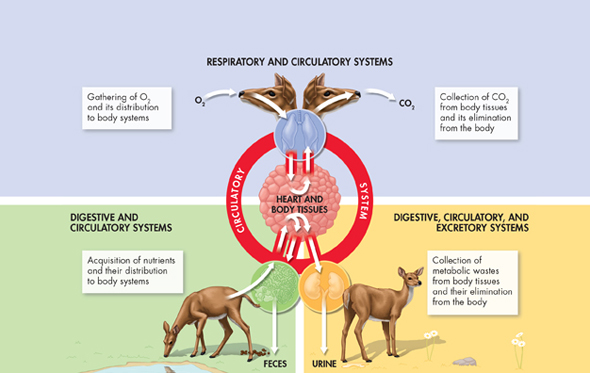VISUAL SUMMARY
MOVING MATERIALS IN, AROUND, AND OUT OF THE BODY
Obtaining and Distributing Oxygen and Nutrients All animals must breathe to obtain oxygen. Small animals that live in water or in wet places can “breathe” by allowing oxygen to diffuse across their skin. Larger animals use a respiratory system based on one of many different kinds of gills, lungs, or air passages. In addition, all animals must eat to obtain nutrients. Most animals have a digestive system that acquires food and breaks it down into forms cells can use.
After acquiring oxygen and nutrients, animals must transport them to cells throughout their bodies. For many animals, this task of transporting oxygen and nutrients requires some kind of circulatory system. Therefore, the structures and functions of respiratory and digestive systems must work together with circulatory systems, as shown in Figure 25–5. Among vertebrates, including humans, the circulatory system is especially important in supplying oxygen and nutrients. In humans, for example, brain tissue begins to die within moments if its blood supply is interrupted by a stroke.
Collecting and Eliminating CO2 and Other Wastes Animals' metabolic processes generate carbon dioxide and other waste products. Some of those waste products contain nitrogen, often in the form of ammonia. Both carbon dioxide and ammonia are toxic in high concentrations. So these wastes must be excreted, or eliminated from the body.
Table of Contents
- Formulas and Equations
- Applying Formulas and Equations
- Mean, Median, and Mode
- Estimation
- Using Measurements in Calculations
- Effects of Measurement Errors
- Accuracy
- Precision
- Comparing Accuracy and Precision
- Significant Figures
- Calculating With Significant Figures
- Scientific Notation
- Calculating With Scientific Notation
- Dimensional Analysis
- Applying Dimensional Analysis





